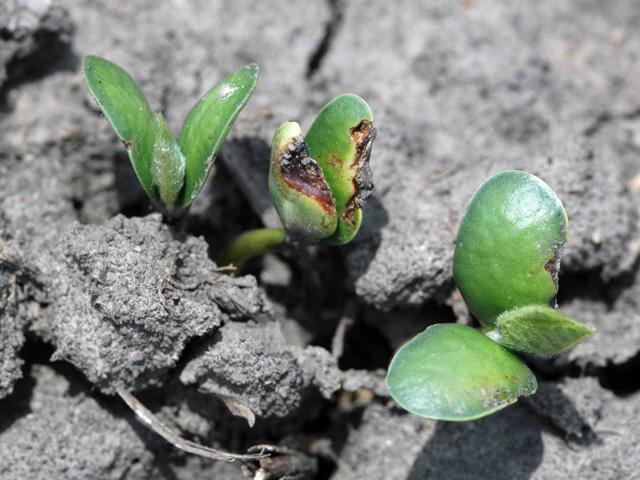Beware Herbicide Hangovers
Here's How to Evaluate Your Herbicide Carryover Risk for 2022
ROCKVILLE, Md. (DTN) -- Will your soil be nursing a herbicide hangover this spring?
Weed scientists are warning that persistent drought in the northern Midwest in 2021 may have left behind more than just shriveled yields. Herbicides might also be lurking in the soils, leftover from summer and fall applications made in dry conditions.
"Not everyone will have this challenge, but I am absolutely certain that in some areas of Minnesota, we will have some carryover problems," warned Tom Peters, an agronomist and weed specialist with both the University of Minnesota and North Dakota State University. The risk will likewise be high for any growers where dry conditions in 2021 have persisted this winter, such as the Dakotas.
Peters, who spoke during a University of Minnesota webinar on Feb. 2, highlighted four factors that will influence a field's likelihood of herbicide carryover: the herbicides used, rainfall amounts, temperatures since the application and soil type.
Here's a quick look at each.
COMMON HERBICIDE CULPRITS
All herbicide labels list plantback restrictions, designed to help farmers avoid herbicide injury on the next crop planted. Keep in mind that those intervals are just guidelines, Peters said.
"Actual environmental conditions such as rainfall, temperature and soil type are going to dictate the likelihood of carryover," he warned.
Some common herbicide culprits to watch are those with long residual lives in the soil, Joe Ikley, a North Dakota Extension weed scientist, noted in a university article.
That includes chemicals such as atrazine, fomesafen, imazthapyr and metsulfuron. "Perhaps the most commonly used herbicide with a long half-life is clopyralid, which is found in WideMatch, Curtail, and similar products," Ikley wrote. "Clopyralid has an average half-life of 40 days, but this has ranged from 12 to 70 days across soils and environments."
P[L1] D[0x0] M[300x250] OOP[F] ADUNIT[] T[]
BLAME IT ON THE RAIN
Soil residual herbicides are "activated" when rainfall moves them into the top few inches of the soil, near young weed seeds and seedlings. Then, when those baby weeds imbibe water from the soil, they also take in the herbicide.
So, soil moisture levels are key not only for herbicide activation, but also to keep that herbicide working after activation, Peters explained.
"Just because you got a herbicide incorporated into the soil with rain, doesn't mean it's going to be available for you in the soil," he said. "It has to be within the soil solution to work. As soil dries, the herbicide will move out from the soil water solution back to the absorption sites on soil colloids, reducing availability to emerging weeds."
So how much rain do you need? Peters says six inches of rain throughout the application season is a good place to start.
"My rule of thumb is if you go into your weather data from June 1 to Sept. 1, and you don't measure six inches of rain, I think you need to look at products you used, consider crops you're planting in 2022 and investigate if you need to worry about carryover," he said.
Individual herbicide labels may also give estimates on how much rain is needed to avoid carryover, Ikley added. For example, the WideMatch (clopyralid) label warns growers they should wait 18 months after an application before planting field peas, unless they received more than 7 inches in the past 10.5 months and 5.5 inches in June through August.
"Keep in mind that summer rainfall events can be variable and your fields may have received more or less rainfall than the nearest weather station," Ikley added.
HERBICIDES LIKE IT HOT -- OR AT LEAST WARM
The ideal environment for a herbicide to degrade is in warm, wet soils, with bustling microbial activity.
Peters pegged the best temperatures for this process between 70 and 80 degrees. Those are easy numbers to hit in the summer months, but not in the fall, he noted.
"As a result, you can't be as sure that fall rainfall means herbicide degradation," he warned.
Winter isn't a help, either. "It is important to remember that herbicide breakdown does not occur in frozen soils," Ikley noted.
SOIL TYPES
Since microbial activity is one of the factors influencing how quickly a herbicide breaks down, soils with low organic matter can be at higher risk for carryover in general, Ikley said. Sandy soils and sandy spots in a field can also be at risk, as they remain drier than heavier soil types.
Soil pH is also in the mix, due to the way it interacts with certain herbicides. High pH soils can reduce the breakdown of sulfonyurea and triazine herbicides, for example, Ikley said.
And low pH soils can cause problems, too. "Specifically, the imidazolinone herbicides (imazethapyr, imazamox) will persist for longer in low pH soils ( less than 6.0 ) and will be another consideration as more areas with low soil pH are recognized," Ikley said.
For more information, view the University of Minnesota webinar here: https://extension.umn.edu/… and read Ikley's article here: https://www.ndsu.edu/….
Emily Unglesbee can be reached at Emily.unglesbee@dtn.com
Follow her on Twitter @Emily_Unglesbee
(c) Copyright 2022 DTN, LLC. All rights reserved.






